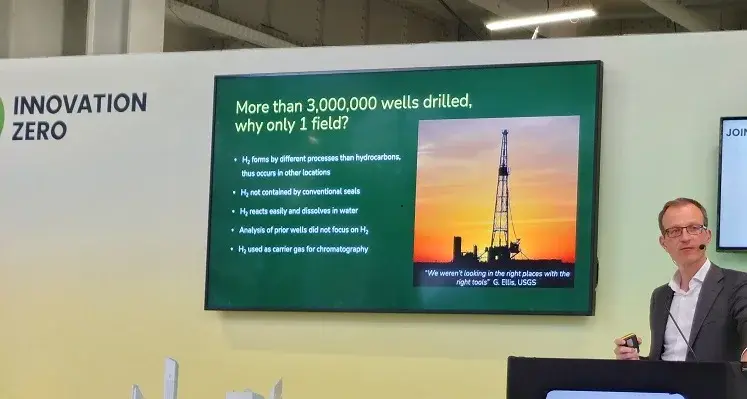The role that hydrogen can play in the drive to net-zero, in particular in decarbonising the hard to abate sectors, is widely recognised
However, natural hydrogen, otherwise known as white hydrogen or geological hydrogen, has received relatively little attention to date, compared with other forms of hydrogen. That could all be set to change, according to Max Brouwers, chief business development officer at Getech, who gave a presentation on the potential of natural hydrogen at the Innovation Zero event in London.
Brouwers noted that the IEA predicts demand for hydrogen to reach 430 Mtpa by 2050 (it currently stands at around 95 Mtpa). Currently around 95% of hydrogen produced is grey hydrogen (produced from natural gas or methane without carbon capture) – which is relatively low cost to produce but high in emissions, ie 1t H2 emits 10-12t of CO2. But by 2050, 98% needs to come from clean sources, and be affordable and secure.
“Blue hydrogen is getting closer to where we want to be. It is the same as grey hydrogen, but the CO2 generated is captured and stored underground," Brouwers noted. “However, a lot of energy is used in this process, so the cost is higher.”
He added that green hydrogen, produced from water electrolysis using a clean energy source and therefore emissions free, is not cheap. “A number of projects started with great enthusiasm are stalled and not reaching FID; offtake is not happening, because the price is too high,” he said.
Increasing interest
This is where natural hydrogen could come in. Brouwers pointed out that this is now drawing quite a lot of interest, with a number of press articles in the last six months highlighting this phenomenon. A survey from United States Geological Survey (USGS) says there is enough natural hydrogen underground to meet all demand for more than 100 years. There are an enormous number of startups focusing on natural hydrogen, with around 50 companies now looking for it in the subsurface.
In addition, the number of oil and gas and mining companies are actively starting to exploring for it, and service companies are joining in as they also see the potential. It is starting to really attract capital. KOLOMA, for example, which has developed the technology to identify, access, and produce geologic hydrogen, raised an additional US$250mn last year from investors following an initial US$100mn.
Decades of research has gone into natural hydrogen, and now with the realisation that green hydrogen may not be so attractive from a commercial point of view, it has started to receive additional focus, Brouwers said.
Natural hydrogen is present in many places. More than 3mn wells have been drilled, but there is currently only one commercial field, in Mali, which was in fact discovered by accident. This field has been in production since 2012 with 24 wells, providing electricity for the local population. While it has been producing for around 12 years, reservoir pressure remains stable, and composition varies per well, indicating a dynamic resource.
But why is there only one commercial field? “The bottom line is, we have not been actively looking for natural hydrogen,” said Brouwers. “But now, with a different mindset, we can actually start hunting for it.” As G. Ellis from USGS commented, “We weren’t looking in the right places with the right tools.”
Brouwers explained that Getech is drawing on its almost four decades of subsurface expertise and understanding, looking for oil and gas and critical minerals, to look for the key characteristics and elements which indicate the presence of natural hydrogen.
“The bottom line is we can hunt for natural hydrogen, we can predict, based on existing data, where it is likely you can find it,” he said. He further outlined how the company uses a combined prediction and detection approach to guide exploration.
Above ground factors are also important, Brouwers added. “We know from green hydrogen that it is important to also have the offtake in play. We need to understand the fiscal regime and potential customers in order to sell the hydrogen.”
Concluding, he said, “Natural hydrogen is an emerging opportunity with transformational capabilities. Natural hydrogen is carbon free, and fully aligned with the energy transition. It is present globally in the subsurface, and there are proven discoveries. We need to take into account that assessments might be slightly different to what we have seen in oil and gas, but the potential is very large, and we welcome working with companies who want to explore for natural hydrogen.”









